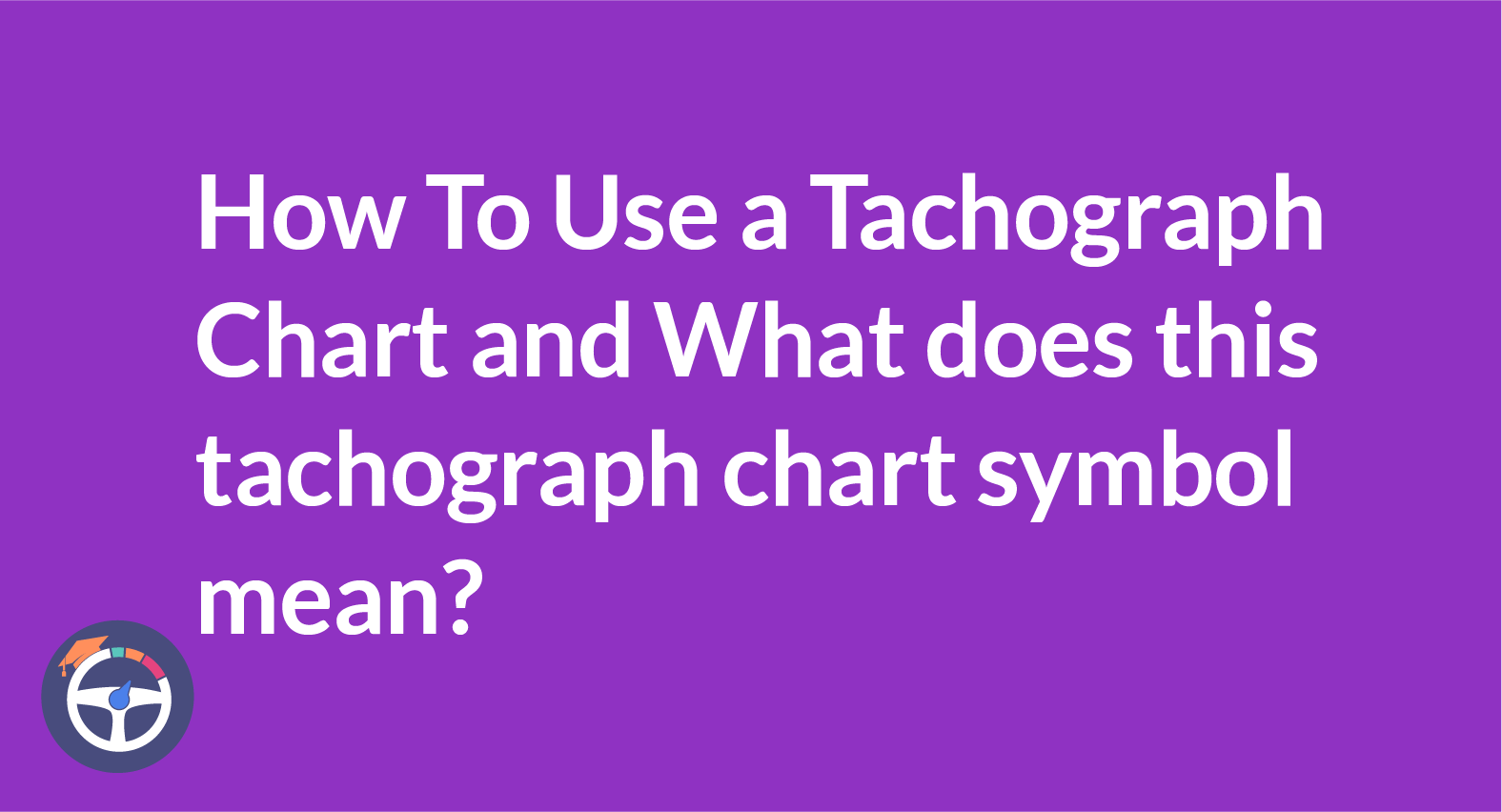Everything You Need To Know About Tachograph
A tachograph records a driver's driving time, speed, and rest periods, with symbols like the steering wheel for driving, bed for rest, and crossed hammers for other work to track activities.

Contents
- Everything You Need To Know About Tachograph
- Why Know The Tachograph Symbols?
- Importance Of Understanding Tacho Symbols And Their Meanings?
- How Are Symbols Displayed On A Tachograph?
- What Are The Names Of Tachograph Symbols?
- What Other Tachograph Symbols Are There?
- How To Use A Tachograph?
- That’s A Wrap!
- FAQ
- What penalties can drivers face for non-compliance with tachograph regulations?
- Can tachograph data be used as evidence in legal proceedings?
- Are there exemptions from tachograph requirements for certain vehicles or journeys?
- How often should tachograph records be kept and maintained?
- Can tachograph systems be tampered with or manipulated?
Are you gearing up for your UK Theory Test and want to master the intricacies of tachographs? Look no further! In this comprehensive guide, we'll cover everything you need to know about tachograph symbols meanings. This includes how to use them, understanding their symbols, and their significance for drivers.
Using a tachograph chart may seem difficult at first. But it's a crucial skill for professional drivers. The chart records various aspects of driving time, breaks, and rest periods during a journey. Understanding the symbols on the chart is crucial. It ensures compliance with driving regulations and enhances road safety.
Why Know The Tachograph Symbols?
Knowing tachograph chart symbols is vital for drivers who operate commercial vehicles. These symbols convey important information. They include details about driving time, rest periods, and other work-related activities. Understanding them helps drivers stay compliant with regulations and manage their driving schedule effectively.
Importance Of Understanding Tacho Symbols And Their Meanings?
Understanding tachograph symbols is crucial for drivers. It enables them to navigate complex driving regulations and prioritize road safety. These symbols serve as visual indicators of critical aspects. Some aspects include driving time, rest periods, and other work-related activities. By grasping the meanings behind these symbols, drivers can effectively manage their journeys. They ensure adherence to mandated rest periods and driving limits. This knowledge not only helps drivers comply with regulations. It also reduces the risk of fatigue-related accidents. Ultimately, this contributes to safer roads for all users.
Moreover, comprehension of tachograph symbols allows drivers to plan their journeys more efficiently. They can optimize their time on the road while still prioritizing rest and breaks. With a clear understanding of the symbols and their implications, drivers can strategically schedule rest periods. This will help prevent exhaustion. This helps maintain alertness behind the wheel. Additionally, this understanding empowers drivers. It enables them to recognize potential issues or discrepancies in their tachograph recordings. It enables them to address these issues promptly and ensure accurate and reliable record-keeping. Overall, the importance of understanding tachograph symbols cannot be overstated. It is integral to fostering a culture of compliance, safety, and responsibility among drivers on the road.
How Are Symbols Displayed On A Tachograph?
Symbols on a tachograph are displayed through various indicators and markings on the tachograph chart. These symbols represent different activities such as driving, rest periods, breaks, and other work-related tasks. Drivers must interpret these symbols correctly to comply with regulations and ensure road safety.
What Are The Names Of Tachograph Symbols?
Tachograph symbols have specific names that reflect their functions and meanings. Some common symbols include:
Tachograph Driving Symbol:
The Tachograph Driving Symbol represents periods when the driver is actively driving the vehicle. This symbol typically appears on the tachograph chart during driving sessions. It indicates to both the driver and regulatory authorities that the vehicle is in motion. The driver is responsible for operating it. The duration of driving time recorded by this symbol is subject to regulations. These regulations govern maximum driving hours without breaks or rest periods.
Tachograph Other Work Symbol:
The Tachograph Other Work Symbol denotes activities performed by the driver other than driving. This may include tasks such as loading or unloading cargo. Administrative duties related to the journey are also covered. Additionally, any other work-related activities are included. It serves as a record of time spent on non-driving tasks during the driver's shift. Proper interpretation of this symbol ensures accurate tracking of overall work hours. This includes both driving and non-driving activities.
Tachograph Available Symbol:
The Tachograph Available Symbol indicates periods. Specifically, when the driver is available for work but not actively driving! During these periods, the driver may be waiting for assignments. They could also be resting or performing tasks that do not require driving. This symbol helps monitor the driver's availability for work. It ensures compliance with regulations regarding rest breaks and maximum working hours.
Tachograph Break Symbol (or Rest Period Symbol):
The Tachograph Break Symbol indicates when the driver takes breaks or rest periods during their shift. It is also known as the Rest Period Symbol. These breaks are essential for preventing fatigue-related accidents. They ensure the driver remains alert and focused while driving. The duration and frequency of rest periods recorded by this symbol must comply with regulations. These regulations govern mandatory rest breaks and maximum continuous driving hours.
By understanding and correctly interpreting these tachograph symbols, drivers can effectively manage their driving schedules. This will ensure compliance with regulations. And prioritize safety on the road for themselves and other road users.
What Other Tachograph Symbols Are There?
In addition to the main symbols mentioned above, various other tachograph symbols represent specific activities. It could also represent events during a journey. These symbols may include indicators for manual entries, faults, or anomalies in the tachograph recording.
How To Use A Tachograph?
- Using a tachograph involves several steps.
- Log in with your unique identification, like a driver card.
- Choose the mode for your activity: driving, other work, availability, or rest.
- Insert your driver card into the tachograph slot.
- Start driving by selecting the driving mode.
- The tachograph will automatically record your driving time, breaks, and other work activities.
- Switch to rest mode for breaks and ensure accurate recording.
- Change modes based on your activities throughout the day.
- Switch to the appropriate mode to signify the end of your driving shift.
- Log out and remove your driver card.
- Review the recorded data periodically for accuracy and compliance.
It's crucial to follow the instructions provided by the manufacturer and familiarize yourself with the specific features of the tachograph system you're using to ensure proper usage and compliance with regulations.
That’s A Wrap!
Understanding tachographs and their symbols is essential for drivers. Especially those operating commercial vehicles! By familiarizing themselves with tachograph charts and interpreting symbols correctly, drivers can ensure compliance with regulations. They can manage their driving schedule effectively. And prioritize road safety for themselves and other road users.
FAQ
1. What penalties can drivers face for non-compliance with tachograph regulations?
Drivers may face fines, license suspension. They can even face prosecution for failing to comply with tachograph regulations.
2. Can tachograph data be used as evidence in legal proceedings?
Yes! Tachograph data can be used as evidence in legal cases involving road traffic incidents or regulatory compliance issues.
3. Are there exemptions from tachograph requirements for certain vehicles or journeys?
Yes, some vehicles and journeys are exempt from tachograph requirements. Like vehicles used for emergency services or short-distance journeys!
4. How often should tachograph records be kept and maintained?
Tachograph records should be kept for at least 12 months. And be readily accessible for inspection by regulatory authorities.
5. Can tachograph systems be tampered with or manipulated?
Tampering with tachograph systems is illegal. It can result in severe penalties for drivers and operators. Regulatory authorities closely monitor tachograph data integrity. This helps prevent tampering and ensure compliance.


